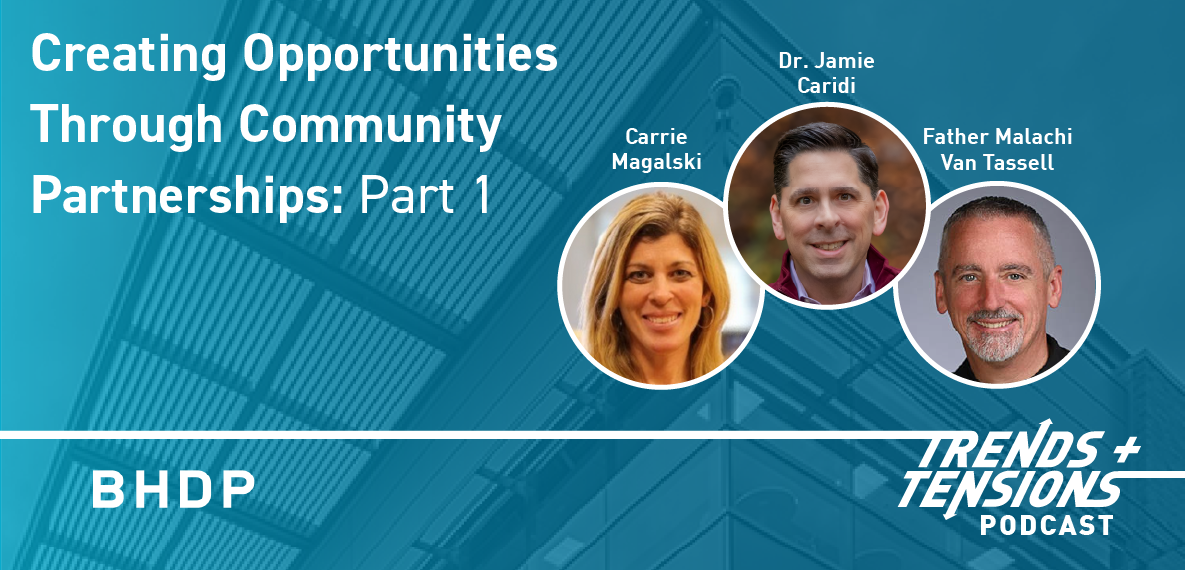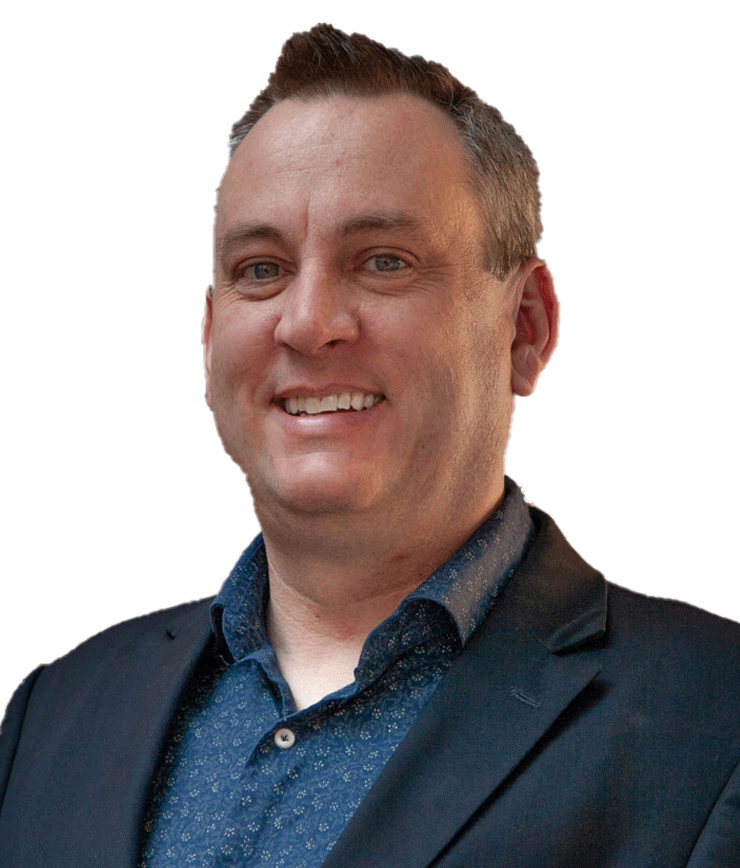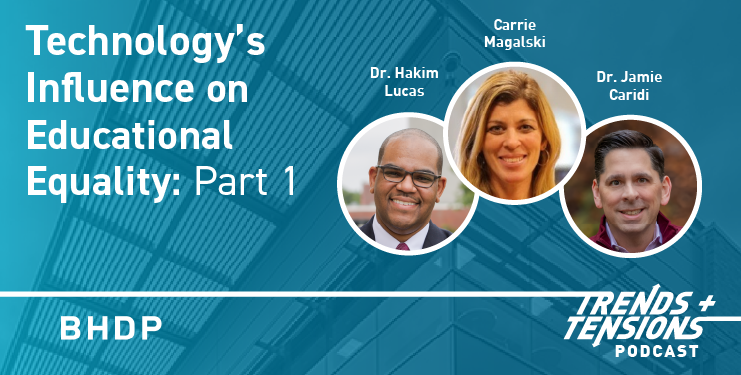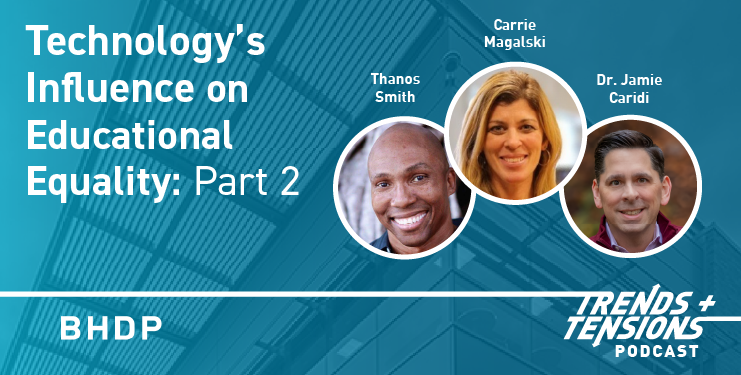
Creating Opportunities Through Community Partnerships: Part 1

Want to listen on another platform? Choose your platform here.
Episode Transcript
(Music Intro)
Brian Trainer, Host: Welcome to a special edition of Trends + Tensions presented by BHDP, where we discuss trends in architectural and interior design and the competing priorities or tensions that arise from integrating new ideas into existing organizations, enterprises, and institutions. This episode is part of the Higher Education Strategic Partnership series. In this episode, “Creating Opportunities Through Community Partners Part One,” special guest hosts Dr. Jamie Caridi, President of Terra Firma, and Carrie Magalski, Director of Client Services for Terra Firma, chat with Father Malachi Van Tassell, President of Saint Francis University, about the strategic partnership the university has started with the Curry Family of Businesses that resulted in the creation of the Curry Innovation Center in downtown Altoona, PA. I'm your host Brian Trainer, Senior Strategist for BHDP. Let's get started.
Dr. Jamie Caridi: So, Father, before we start getting into it, a lot of this project became about how we want to tell the story of the Curry Center, but we don't want to start there, honestly. We want to hear a little bit from you. You've been a president, and you probably don't feel like you've been doing it that long, but you've now been there, what? Eight years?
Father Malachi Van Tassell: Yeah, eight and a half years, or was I like to say, in my ninth—I was always looking forward. Yeah, so I've been in the presidency for almost nine years. I've been at Saint Francis University—I’m in my 21st year. So, I started here as a faculty member in the Shield School of Business. I taught accounting full-time and part-time. I have a taxation background. I came out of public accounting with a Master’s in Tax. So I came to the presidency through the finance side of things, and I've always had an eye to the institution through a business lens. As a faculty member, I adore the academy, I have an appreciation, obviously, for academia and its practices and its customs, but looking at the institution through a business lens, I realized the importance of some of the basics—surplus versus deficit—but also, the importance of revenue streams, diversification of revenue streams, especially for a small school like us. That lens really guided my path as I came into the presidency, especially in the early years, just looking at the financial health of the institution but also realizing that demographically, there are challenges out there, and wanting to poise the institution to do well financially, but ultimately, so that we can project our mission. We're a small Catholic school. We want to be in business for many years because we want to educate young people of faith to go into the world and be light in the darkness. The mission is my primary thrust, but the business background that I bring has really helped in many ways to move us forward to do some exciting things.
Dr. Caridi: It was interesting—when we first started talking with Aaron and Frank, it became clear that you've got a number of interesting things going on strategically right now. So, we got off the call with them, and our biggest challenge, we thought, was, “How are we going to crystallize and synthesize this into a story?” because you've got a lot going on, which, I guess, doesn't surprise us. Entrepreneurial spirit tends to have a lot of creativity with it. As you and your senior leadership team and your board kind of thought through—can you share a little bit about your mindset around kind of putting a stake in the ground around the Curry Innovation Center?
Father Van Tassell: Well, absolutely.
Dr. Caridi: I don’t want to say, “going all in on that,” but at a certain point, you kind of have that moment where, “Okay, we've been talking about this for a while. Now it's real.”
Father Van Tassell: In 2018, we restructured. In 2019, we're moving forward—we’re trying to emerge from a restructuring with an innovative spirit. And by 2020, right, as the pandemic is hitting, we're emerging from restructuring with an innovative spirit, and we're looking to do new things. Concurrently, I had charged Frank to be the Vice President for Innovative Partnerships, and that was a decision I made back in 2016 because we recognized then that we had to find new revenue streams. And so I said to Frank, the three criteria are: you look for an innovative partnership that brings new students, additional revenue, and/or creates employment opportunities for graduates. Any one of the three works. So that's been his charge. So here we are going through a restructuring, a pandemic is hitting, and yet, we decide to invest a significant amount of money in a property in downtown Altoona. We're friends with the Curry Family of Companies, and they checked the box in terms of opportunities for graduates. Current students of ours are doing significant internships at the Curry company. Curry is hiring our graduates. Curry is looking at us, saying, “We want you to be our research arms.” So the relationship with Curry converges with an opportunity to be in their headquarters in downtown Altoona. Here again, we were looking at it through innovative eyes—entrepreneurial eyes—and we know, too, that the presence there is going to get our name out there, it's going to get high school students aware of us, get the community aware of us, and pull them in that way. So honestly, we see our presence with Curry as an enrollment driver. On one level, it's an entrepreneurial relationship. On another level, it's an enrollment driver for us. Even if a student is not coming to us for chemistry or engineering, we can still say, “Look at this awesome partnership we have where, from college freshmen to employment, you're with this company and getting awesome experience.” It’s a long answer, but it's twofold—there’s the entrepreneurial piece, but then, also, the enrollment driver.
Dr. Caridi: It’s a huge window now into the university, right?
Father Van Tassell: Absolutely. And honestly, not to start parading around and be prideful, [laughs] but it makes a statement, the fact that the university is investing in a property in this point in history. It is significant. It is bold. It is a risk. It has gotten us noticed. A competitor institution has been across the street from our location for many, many years, and they noticed our presence down there.
Dr. Caridi: Yeah, I'm sure they're thrilled. [Laughs]
Father Van Tassell: [Laughs]
Dr. Caridi: So, one of the things we know is happening, and Paul mentioned this, is that everybody's talking about strategic partnerships, whether it's with other educational institutions, corporations, government entities, non-profits, etc. We know the world has shifted in higher ed, where we all used to have this “go at it alone” kind of mentality because the supply and demand of students worked for us that way, but now I think the pages flip, where presidents know they have to be in partnership, and everybody wants to, but then where the rubber meets the road, how do you do it? One of the things we have witnessed and found is that's where presidents are really struggling. What does that process look like? How do you do your discovery and due diligence, and what is the business model? And even before that, how do you identify who's at the table and what's going on? Because one of the things we want to do here is share a little bit about how presidents actually can take the next step.
Father Van Tassell: There are two parts to that answer. I'll go with the easier answer first in terms of the partnership itself—the relationship with Curry. In many ways, that was the easy part because just by geographic proximity and just by a personal relationship, we knew who Curry was, and they knew who we were. As we started having discussions, it was very evident that not only did they like our students, they wanted our graduates because they needed engineers. So they had a need. I was proud of our people who were at that table—that would be the Vice President for Innovative Partnerships, the Dean of the School of STEEM, engineering professors—a small group of people who are saying to the Curry folks, “Yeah, we can do this, we can do that, we can do the other thing, we can we would love to be your research arm.” So that part of it was the easy part for us. Key people in the conversations knew that this would work. We knew that we would work well together. The challenge, then, is going back to the institution, which is very traditional, and academia has its mores and its customs, and it's saying to an academic institution, “Here's someone that we want to partner with, and here's why.” So we really had to make the case as part of the educational process to the faculty and to the staff and say, “Hey, this is Curry. This is who they are; this is what they do. Look what we can do with them. See what the opportunities will be for our students.” As more faculty heard of this, they saw an atraditional opportunity, and then they said, “Oh wow. This can really work for us. This does create opportunities for our students.” So, we did more of a road show with the traditional university community. Once we got the buy-in and once we built the case and showed the benefits, then we moved it forward. It could be challenging at some institutions, particularly if there's a reliance on the process, like if the faculty senate has to approve things or if there needs to be board approval. We know that higher ed doesn't move fast. So I think the challenge for the president is moving the concept to reality through the halls of academia. That could be where the challenge comes in. That’s also where leadership comes in.
Carrie Magalski: Was this your first brick-and-mortar business model or partnership, or did you have anything to reference in the past with experience?
Father Van Tassell: For this administration, it was the first brick-and-mortar project with a partner like this. Yeah, this is this was a first. We have a significant partnership with another group, but that would be more on the academic level, the sharing of resources level, etc. More intangibles, if you will. So, you're right. That’s a great question. This was the first on-ground, in person. And yeah, the university was shelling out cash to invest in a building which we will occupy for many years to come. But here again, we see it as an investment, and the return on the investment for us is also measured in terms of how many students do you recruit. That factors into the term.
Dr. Caridi: Yeah, I've always known Saint Francis. Again, I'm a Pittsburgher, born and raised. I lived out in Latrobe and Derry for 15 years. I've not been in that area for the last 20 years, but I always thought of Saint Francis as traditional-aged undergraduates. But it seems, as I learned about the Curry Center, that there's kind of a disciplined effort here. I saw there was a program, an organizational leadership, etc., to speak to a different student population as well. Is that correct?
Father Van Tassell: It is. This project, in some ways, pushes open the door to do more bold, intentional, different things than you would expect from higher education. Traditional higher education is wonderful, but we have to be bold and different. So, the Curry partnership is emblematic of there are more things to come. This is not the last of our innovative partnerships, and you hit it—this springboards us into areas like workforce development, areas like aviation maintenance, healthcare technician, okay. The list can go on and on. It pushes that door open, and the critics will say that a university has no business going down that road, but I beg to differ because, from a mission point of view, we're about educating students in the Franciscan and Catholic tradition. And we can do that in any number of venues with any number of demographical groups. So I look at the Curry building, I say, “That building is going to be the space in which we help to do workforce development in Blair County and beyond.” So, this is the start of many more out-of-the-box projects for Catholic higher ed. As a leader, I do what I believe is right, I do what I believe is best for the institution, but we educate people, and we try to bring them along with us, too.
Carrie: You touched upon the enrollment aspect. So, for during orientations and driving up enrollment, have you seen the community or prospective parents or prospective students coming in excited about some of those opportunities for outcomes?
Father Van Tassell: I have. We have. Particularly, we think of tangible examples. We can say, if we wanted to have an event at Curry Manufacturing Company, “If you're a prospective general engineering student, come to our reception at Curry Manufacturing,” and “Oh look, they're making this railroad car from start to finish.” You walk through the factory, and you see where the engineers work, and you say to the kid, “This can be you one day.” That's an amazing sell feature. Now that the building is open and operational, the admissions side of the house is really coming into play now to host these events either in the Curry building itself at the Curry Company. We're going to do a financial aid night for students of the region in the Curry building, so we're doing everything we can to get prospective folks in there because, again, like with the campus tour, once you get them in, then you can hook them. We're trying to get as many high school kids as we can coming in through this building.
Carrie: I would think, too, since internships are such a huge part of that academic experience, so having that part of that process in their academic experiences would be pretty important, too.
Father Van Tassell: Absolutely. Plus, with the opportunity for guaranteed employment at the end of it all, when Mom and Dad hear that, then there's no more discussion.
Carrie: Yes. Get a thumbs up [laughs].
Dr. Caridi: I'm thinking of the audience that’s going to be reading and listening and learning from this, and it's largely going to be presidents and boards and management teams, and I guess I have two questions here. One is going to be, “What was one of the greatest obstacles you encountered, whether you knew you were going to encounter it or it kind of came up along the way?” And then—just some tips or advice to that audience, as they're thinking of being bold and taking on an initiative like this—what counsel do you have for your colleague presidents as they live into trying to do what you're doing?
Father Van Tassell: Well, I think I'll answer the second one first. The term that I've heard over the span of my presidency is ‘courageous leadership.’ Okay, and I don't know who coined the term, but in the higher ed space, I hear that term used. What a president or an academic leader does—they say that is courageous leadership because they know what needs to be done, and they do it. And really, the longer I'm in this job, the more I have an appreciation for courageous leadership. I recognize it when I see it, and I would say that for something like this if it makes sense for the institution—if it's something that will pay dividends for the institution, even if there's going to be pushback from certain quarters—this is where courageous leadership comes in. As I like to say, these things don't happen by magic. Things don't get better if you sit and hope they do. Sometimes you have to take the action. I would say to a president, “Go for it. Do it because no one else is going to do it. But if this is the right thing for the institution, do it.” To the first question, to be honest with you, I'm hard-pressed to think of a single obstacle except for the intangible. It's the risk involved, the worrying, the concerns voiced by multiple people asking, “Why are we doing this? How come we're doing this in Altoona and not Johnstown? Maybe we could do something in Pittsburgh. Maybe we should look for an enrollment pipeline in Houston, TX.” So, there's all kinds of wondering, “Why are we doing this? Why here? Why now?” Some of the pushback was strong. Some of the pushback had merit, so in other words, it wasn't, “Well, we don't have enough cash,” or “We can't find a building company.” It wasn't the practical stuff. It was really just the genuine concern on the part of some, but once we overcame that, once we educated the folks, maybe they all didn't come around to our way of thinking, but they at least saw our thought process. They saw there was a plan. They understood the details. “Okay, we may not agree with you, but we get it.” Clearly, you've done your homework.
Dr. Caridi: Carrie, what other key questions do we need to ask Father?
Carrie: That was one of the important questions—what you had asked, Jamie—and Father, what you said about the giving counsel. I think right now, we're in unprecedented times; we’re just seeing things that we've never seen before in the economy, in the world; just to be innovative on and being strategic on some of these practices is important for a successful partnership. You're seeing this center also benefit the community. Are you getting feedback from the community, from the town? And how is that helping you as far as seeing that success there?
Father Van Tassell: Our presence has definitely raised our profile. Respected business leaders in our community are walking up to us and saying, “Wow, thank you for coming here. We're happy to have you. Thanks for making the investment,” because they, too, are making an investment. And these are folks, too, who have lived here a long time. In many situations, it's the next generation of leadership, if you will. These are the young business leaders who are going to be in downtown Altoona for a long time to come. Well, we're going to be there with them. They have a lot of appreciation, respect, and admiration for what we're doing because, again, we could have picked any number of locations. We could have chosen to go in a completely different direction, not involving brick and mortar. I've been impressed by how happy people are to have us down there, but as we move out of the honeymoon phase, I really do see us working with other business leaders. Again, proximity is going to help us. So, I think things are going to progress naturally, and you're going to see us more and more as a partner and not just a tenant. We're truly a partner in the business world down there. That's huge for us. That's huge.
Carrie: Yeah, and it's probably exciting for the businesses, too, because they've seen something that's been successful, and they're going to want to get involved in some way, so I could probably see more partnerships opening up in the future that you didn't even think of.
Father Van Tassell: I've always wanted us to be partnered with somebody. And it's funny that it converges this way with Curry. I wasn't familiar with that in 2014, but as I came to know people and as relationships develop, this is a great partnership. My VP for Finance, years ago, said something like, “In the future, you're going to take classes on campus and then go finish your education at Google headquarters, and then get your degree.” Well, we're kind of doing that. You're taking classes at St. Francis, but then you get in the real-world stuff at Curry. The more partnerships I can have like that, that's awesome. That's also an area of evolution for higher ed. More and more, there's going to be the experiential piece, and you're going to get college credit for that. I see us replicating this with other companies.
Carrie: Right.
Dr. Caridi: Carrie, how about you? Anything still on your list?
Carrie: No. I loved hearing you, Father, and I am excited about being with you in this process as we are able to share your story.
Father Van Tassell: Thank you so much. My pleasure, thank you. More than anything else, I appreciate the fact that we were selected for this. So thanks for taking an interest in our story, and thanks for amplifying it for us, too. I appreciate it.
Dr. Caridi: You got it, Father. Well, best wishes for a peaceful weekend.
Father Van Tassell: I appreciate it. Have a nice weekend. Thank you.
Carrie: You, too. God bless.
Brian: Thank you for joining Trends + Tensions presented by BHDP for this special episode, “Creating Opportunities through Community Partners Part One,” with contributing hosts Dr. Jamie Caridi and Carrie Magalski, and their guest, Father Malachi Van Tassell. If you appreciate what you’ve heard, please rate, subscribe, and give us a review. I am Brian Trainer, your host, and I hope you'll join us for part two when we continue this topic with university administrators from Saint Francis University and representatives from the Curry Family of Businesses.
Author
Content Type
Podcast
Date
May 24, 2023
Market
Practice
Topic
Higher Education Strategic Partnerships
Innovation



